Ever since the first (non-avian) dinosaur fossils were identified as such, humans have pondered on what it would be like to live alongside such awe-inspiring creatures. Could we keep them captive? Would we want to? Might they even make good beasts of burden, or pets? This year, we’re celebrating the 30th anniversary of a film that brought dinosaurs crashing into the modern world, placing them in an incredible zoo that inevitably failed to contain them. But ten years before that, Robert Mash wrote a silly book. And here it is.

The premise of How to Keep Dinosaurs is quite simple: Mesozoic dinosaurs are around today, and that’s that. No further explanation is given, or indeed, particularly wanted. Since dinosaurs are a part of everyday life, they’ve naturally been exploited by humans like many other groups of animals. Mash’s book is posited as a handy guide to looking after various dinosaur species, with tips on housing, feeding, which are suitable for beginners, which are suitable for meat production, and so on. It’s humorous in a deadpan, rather British sort of way, and the real point is obviously to inform the reader as to what the experts think dinosaurs were like in life.
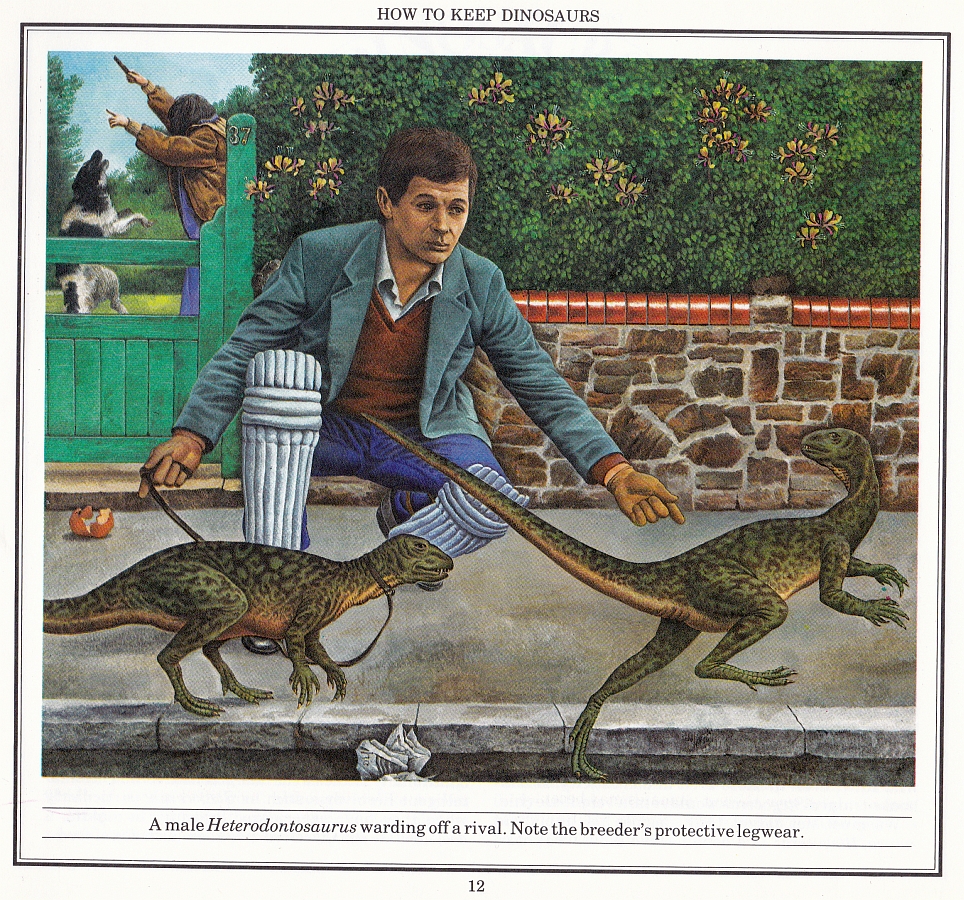
Colour illustrations are provided by Diz Wallis and Philip Hood, with William Rushton providing monochrome cartoons (more on which next time). Wallis illustrated the saddled-up Ornithomimus on the cover, while Hood produced the Heterodontosaurus piece seen above. All the illustrations in this book are immensely charming and packed with amusing details, like the batting pads sported by the Heterodontosaurus handler, which makes it all the more shameful that the more widely available 2003 edition of this book threw them out in exchange for some truly dreadful CG that’s actually aged worse.
Of course, the dinosaurs that appear in these illustrations are a little…familiar-looking, but that’s to be expected. If anything, I’m quite impressed by Hood’s ability to mix-and-match different sources from his well-thumbed copy of Charig’s A new look at the dinosaurs (published in 1979). In the Heterodontosaurus scene, both animals owe something to Peter Snowball’s illustration of the animal from that book, but the one on the right is adapted from a Coelurus that appears in the corner of a Late Jurassic scene.
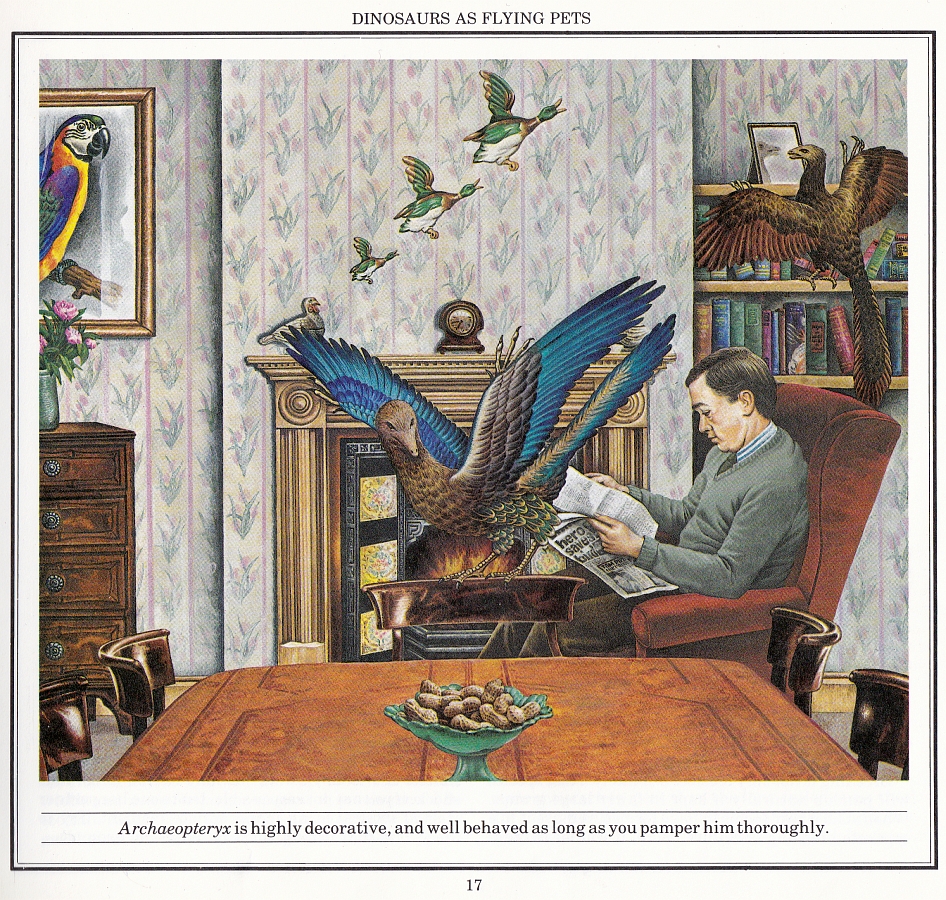
As ever, spotting the palaeoart references is half the fun. In Hood’s Archaeopteryx scene, the individual in the background is clearly based on a model that’s been knocking around the London NHM for donkey’s years. The one in the foreground doesn’t have a specific source as far as I can tell, but it’s definitely in the same ‘wings – but with hands!’ mould. (If only more people had copied Bernard Robinson’s Archaeopteryx, instead of his T. rex…)
All that said, I absolutely love all the little details in this scene, from the ducks on the wall, to the parrot portrait, to the bowl of peanuts, and even the “hero saves bird” newspaper headline. We’re clearly dealing with a bird lover, here, entirely unperturbed as his bizarrely Jurassic avians make a nuisance of themselves in his living room. Oh, and in case you were wondering, the animals are indeed meant to be a male and female – as Mash notes, “the male is much more brightly coloured than the drab female.” A little informed speculation is always necessary with these things (just ask Darren Naish. Or don’t, he’s far too busy. Leave the poor man alone).

As previously mentioned, certain dinosaurs are evaluated for their suitability for meat, and I can’t help but feel that Mash gets a bit carried away when it comes to poor old Plateosaurus. Vegetarians, look away now. “The meat has a pleasing flavour…it is best either well roasted or well stewed…cuts from the sirloin are extremely popular, and should be roasted at a low heat, allowing about 50 minutes per pound,” Mash salivates. “Baste regularly and sprinkle with oregano, thyme or rosemary.” Mash goes on to suggest the use of cider or beer to make the male more controllable. The real animal should probably be grateful that it’s been safely dead for over 200 million years.
The main illustration for this interesting sojourn is provided by Wallis, whose Plateosaurus greatly resembles a mirrored version of Snowball’s. Of course, it’s greatly enhanced by the addition of a group of inquisitive cows. I wouldn’t get so close to that tail, if I were you. Better hope that that sauropodomorph is happy-drunk.
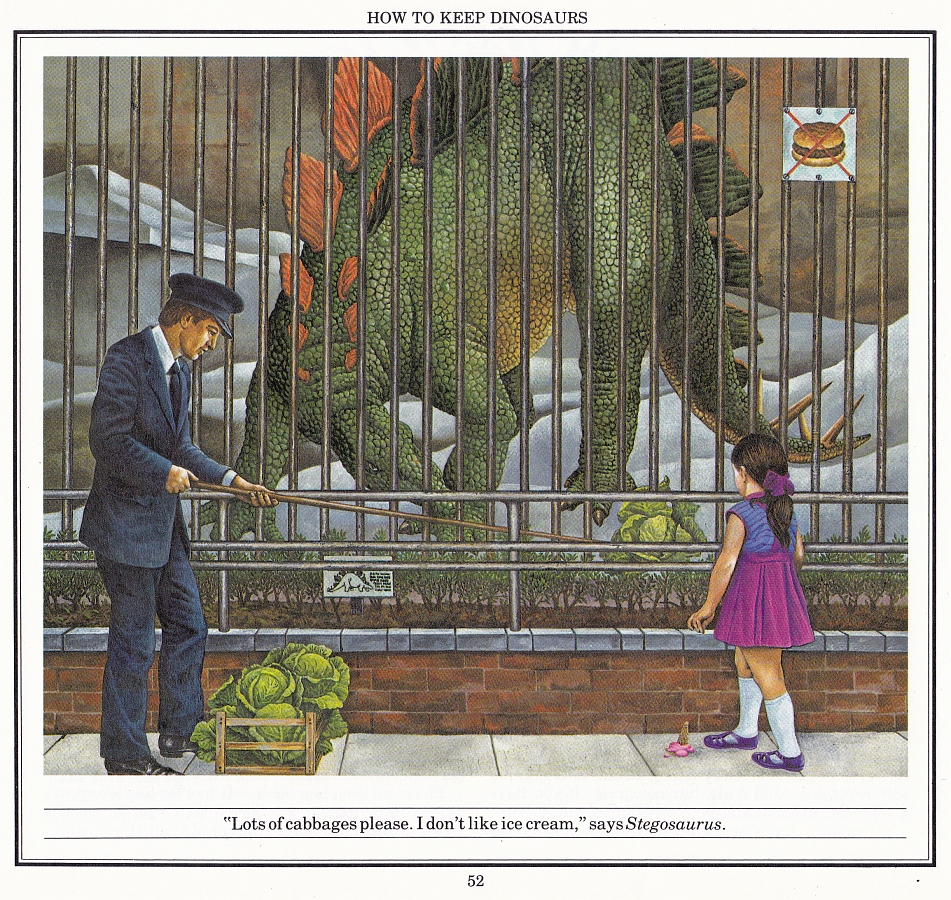
Naturally, some dinosaurs are too large and challenging to keep as pets or even on the farm, and are therefore best suited to zoos. One such beast is Stegosaurus, and Mash expends a great many words on describing how the animal controls its temperature using its plates (but of course). The illustration (by Philip Hood) seems to borrow a lot from Bernard Robinson, particularly in the colouration of the animal and the texture of its skin. It’s also a handy reminder that this would have been considered a fairly normal zoo enclosure not all that long ago. We’ve come a long way, baby. Thankfully. And on which note…
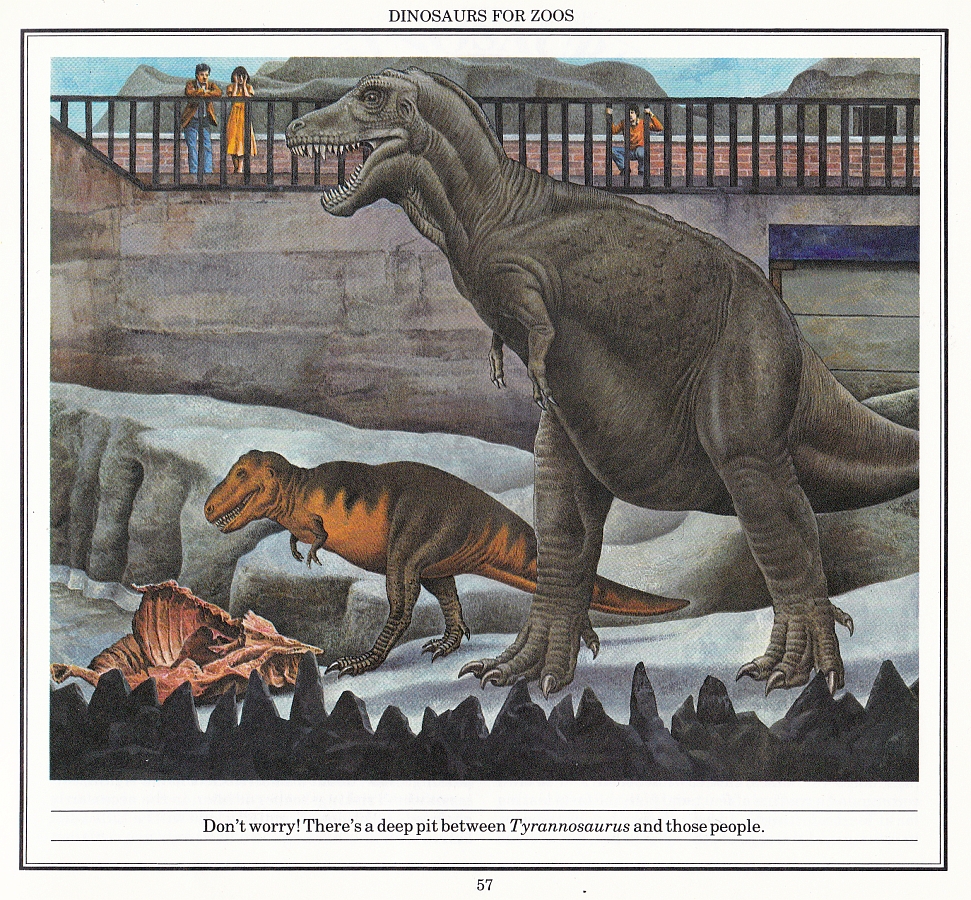
Just as bears were often kept in a literal bear pit, so tyrannosaurs would naturally be kept in a tyrannosaur pit. Here, Hood’s large grey Rexy mixes the body of Snowball’s Tyrannosaurus with the head from a monochrome illustration (credited to Ray and Corinne Burrows) that also appeared in A new look at the dinosaurs. The smaller guy, I’m not so sure about – do let me know in the comments if you think you know the source. Regardless, that’s one alarmingly bleak enclosure they’re sitting in, even if – in terms of visitor safety – it’s actually far superior to Isla Nublar. Mash seems to have a far better idea of how to handle the Tyrant King than Hammond. To wit:
For maximum security and minimum premiums, I suggest that around your Tyrannosaurus pit you build something akin to the Berlin Wall, and that watch be kept around the clock by sentries equipped with searchlights and rockets…Cage in all viewing points or your zoo will almost certainly be the scene of some spectacular murders.
You hear that, John? Spared no expense, my arse.

The largest dinosaurs – that is to say, sauropods – are considered too big for mere zoos, and recommended for safari parks, instead. I just love that Dicraeosaurus is apparently being kept in a paddock surrounding a stately home – it’s highly reminiscent of the various animal parks that have grown up around old country piles in the UK, started by aristocratic nutters with far too much inherited wealth and spare time. (Or Longleat, at least.) Hood’s Dicraeosaurus are rather generic grey sauropods, and that’s because they’re actually based on a Snowball Apatosaurus (foreground) and Plateosaurus (background), with the Plateosaurus being more heavily modified for the purpose.
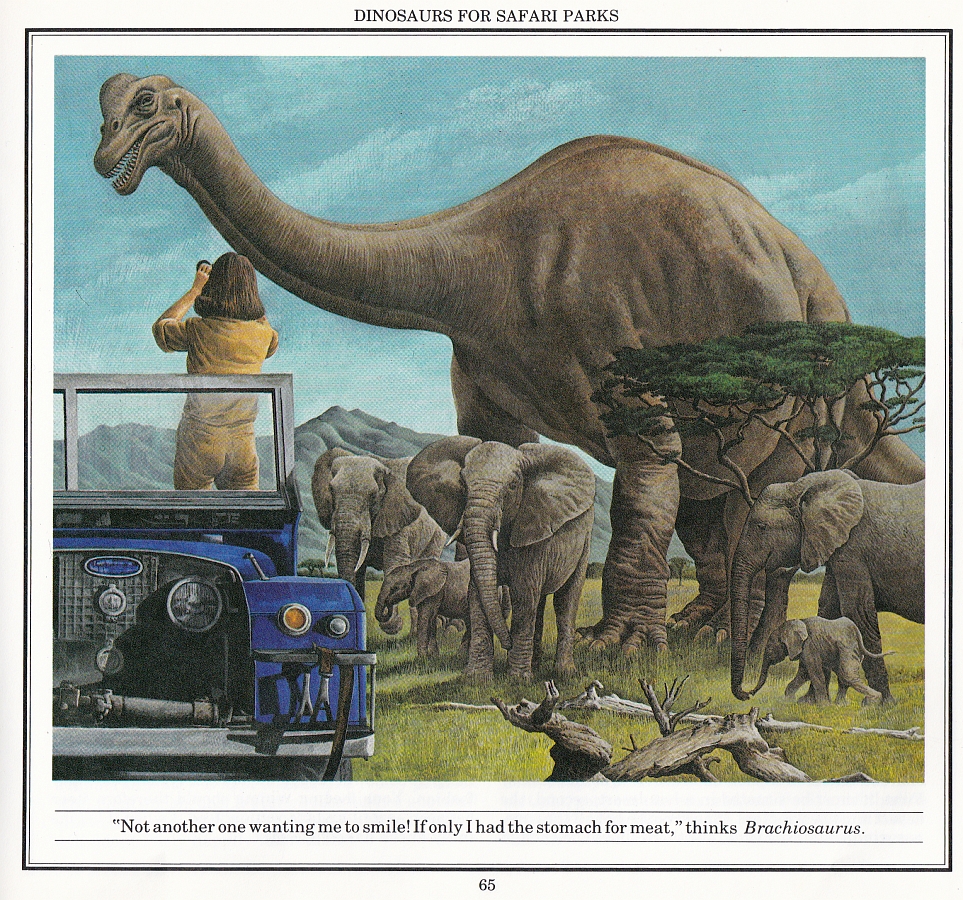
And finally, a very Burianesque Brachiosaurus hanging around with a herd of elephants on safari, as illustrated by Hood. It’s curious that Hood didn’t refer to Snowball’s more modern-looking Brachiosaurus as featured in A new look at the dinosaurs, but then, I guess Burian’s version is simply too iconic not to use. (I do hate using the word ‘iconic’, but it feels apt here – Burian’s Brach is an icon of palaeoart.) It also looks all the more hilariously incongruous, posing for a photo behind the elephants and that series II Land Rover. (What else would you take on safari in the early 1980s?)
There’ll be more to come from How to Keep Dinosaurs, although Prehistoric Planet might get in the way first…




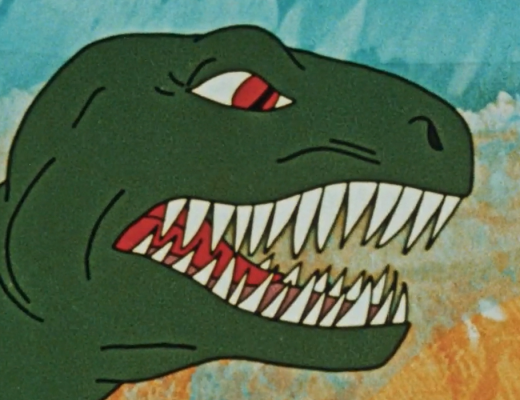


5 Comments
Zain Ahmed
May 17, 2023 at 4:39 pmHuh. I’m more familar with a 2006 version that uses admittedly hideous CG blobosaurs. I remember obessing over it as a kid, wodering what Dinos I’d keep.
https://archive.org/details/howtokeepdinosau0000mash
Marc Vincent
May 17, 2023 at 5:22 pmI do refer to that version in the article.
Niels Hazeborg
May 18, 2023 at 11:00 amPhil Hood’s art style works much better for a whimsical book like this than for the serious book he did with David Norman. https://chasmosaurs.com/2021/08/10/vintage-dinosaur-art-the-prehistoric-world-of-the-dinosaur/
Gray Stanback
May 19, 2023 at 2:50 amOne thing the reprint does have going for it, though, is the silly and often innuendo-filled meanings it gives to the dinosaur names. For example, Ceratosaurus becomes “Horny lizard, from its indiscriminate courtship” and Euoplocephalus becomes “Well-tooled point, in reference to its fertility.”
RONALD MOORE
May 19, 2023 at 4:01 pmSMILE PLEASE